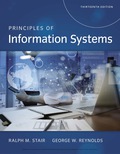
Principles of Information Systems (MindTap Course List)
13th Edition
ISBN: 9781337516945
Author: STAIR
Publisher: Cengage
expand_more
expand_more
format_list_bulleted
Concept explainers
Question
Chapter 14, Problem 1WE
Program Plan Intro
Code of ethics:
- The “ethics” word comes from the Greek term “duty”. The code of ethics means all the responsibilities that professional must respect when carrying out their work.
- It also contains the core value of the work and the behavior which should be adopted.
Example:
Professional and confidentiality secrecy are responsibilities contained in the code of ethics and conduct in numerous professions like accountants, lawyers, doctors and journalists.
Intent of the code of ethics:
- The intent of the code of ethics established by a professional order as a way to safeguard the public and the status of the professionals.
- The employee who breach their code of ethics suffer disciplinary actions that can range from a warning or rebuke to dismissal or ejection from their professional order.
Privacy policy:
- A privacy policy denotes a statement that discloses some or all ways an organization would gather, use, disclose, and manage data of customers as well as clients.
- It fulfills a legal requirement for protecting privacy of customers as well as clients.
- Personal information denotes anything that could be used to identify an individual.
- It represents a generalized treatment that tends to be more specific and detailed.
- The exact content of certain privacy policy will depend upon applicable law and need to address requirements across all boundaries.
Expert Solution & Answer
Trending nowThis is a popular solution!

Students have asked these similar questions
Show all the work
Construct a frequency polygon density estimate for the sample in Question 1, using bin width determined by Sturges’ Rule.
Show all the work
Chapter 14 Solutions
Principles of Information Systems (MindTap Course List)
Ch. 14.1 - What is the harm in nonproductive use of...Ch. 14.1 - Prob. 2RQCh. 14.1 - Do you think that it would help to involve a small...Ch. 14.1 - Prob. 2CTQCh. 14.2 - Prob. 1RQCh. 14.2 - Prob. 2RQCh. 14.2 - Prob. 1CTQCh. 14.2 - Prob. 2CTQCh. 14.3 - Prob. 1RQCh. 14.3 - Prob. 2RQ
Ch. 14.3 - Prob. 1CTQCh. 14.3 - Prob. 2CTQCh. 14.4 - Prob. 1RQCh. 14.4 - Prob. 2RQCh. 14.4 - Prob. 1CTQCh. 14.4 - Prob. 2CTQCh. 14 - Prob. 1SATCh. 14 - Prob. 2SATCh. 14 - Prob. 3SATCh. 14 - Prob. 4SATCh. 14 - Prob. 5SATCh. 14 - Prob. 6SATCh. 14 - Prob. 7SATCh. 14 - Prob. 8SATCh. 14 - Prob. 9SATCh. 14 - Prob. 10SATCh. 14 - Prob. 11SATCh. 14 - Prob. 12SATCh. 14 - Prob. 13SATCh. 14 - Prob. 14SATCh. 14 - Prob. 15SATCh. 14 - Prob. 16SATCh. 14 - Prob. 1RQCh. 14 - Prob. 2RQCh. 14 - Prob. 3RQCh. 14 - Prob. 4RQCh. 14 - Prob. 5RQCh. 14 - Prob. 6RQCh. 14 - Prob. 7RQCh. 14 - Prob. 8RQCh. 14 - Prob. 9RQCh. 14 - Prob. 10RQCh. 14 - Prob. 11RQCh. 14 - Prob. 12RQCh. 14 - Prob. 1DQCh. 14 - Prob. 2DQCh. 14 - Prob. 3DQCh. 14 - Prob. 4DQCh. 14 - Prob. 5DQCh. 14 - Prob. 6DQCh. 14 - Prob. 7DQCh. 14 - Prob. 8DQCh. 14 - Prob. 9DQCh. 14 - Prob. 10DQCh. 14 - Prob. 1PSECh. 14 - Prob. 1TACh. 14 - Imagine that your team has been hired to conduct a...Ch. 14 - Prob. 3TACh. 14 - Prob. 1WECh. 14 - Prob. 2WECh. 14 - Prob. 3WECh. 14 - Prob. 1CECh. 14 - Prob. 2CECh. 14 - Prob. 3CECh. 14 - Prob. 1CTQ1Ch. 14 - Prob. 2CTQ1Ch. 14 - Prob. 3CTQ1Ch. 14 - Prob. 1CTQ2Ch. 14 - Prob. 2CTQ2Ch. 14 - Prob. 3CTQ2
Knowledge Booster
Learn more about
Need a deep-dive on the concept behind this application? Look no further. Learn more about this topic, computer-science and related others by exploring similar questions and additional content below.Similar questions
- Show all the workarrow_forwardShow all the workarrow_forward[5 marks] Give a recursive definition for the language anb2n where n = 1, 2, 3, ... over the alphabet Ó={a, b}. 2) [12 marks] Consider the following languages over the alphabet ={a ,b}, (i) The language of all words that begin and end an a (ii) The language where every a in a word is immediately followed by at least one b. (a) Express each as a Regular Expression (b) Draw an FA for each language (c) For Language (i), draw a TG using at most 3 states (d) For Language (ii), construct a CFG.arrow_forward
- Question 1 Generate a random sample of standard lognormal data (rlnorm()) for sample size n = 100. Construct histogram estimates of density for this sample using Sturges’ Rule, Scott’s Normal Reference Rule, and the FD Rule. Question 2 Construct a frequency polygon density estimate for the sample in Question 1, using bin width determined by Sturges’ Rule.arrow_forwardGenerate a random sample of standard lognormal data (rlnorm()) for sample size n = 100. Construct histogram estimates of density for this sample using Sturges’ Rule, Scott’s Normal Reference Rule, and the FD Rule.arrow_forwardCan I get help with this case please, thank youarrow_forward
- I need help to solve the following, thank youarrow_forwardreminder it an exercice not a grading work GETTING STARTED Open the file SC_EX19_EOM2-1_FirstLastNamexlsx, available for download from the SAM website. Save the file as SC_EX19_EOM2-1_FirstLastNamexlsx by changing the “1” to a “2”. If you do not see the .xlsx file extension in the Save As dialog box, do not type it. The program will add the file extension for you automatically. With the file SC_EX19_EOM2-1_FirstLastNamexlsx still open, ensure that your first and last name is displayed in cell B6 of the Documentation sheet. If cell B6 does not display your name, delete the file and download a new copy from the SAM website. Brad Kauffman is the senior director of projects for Rivera Engineering in Miami, Florida. The company performs engineering projects for public utilities and energy companies. Brad has started to create an Excel workbook to track estimated and actual hours and billing amounts for each project. He asks you to format the workbook to make the…arrow_forwardNeed help completing this algorithm here in coding! 2arrow_forward
arrow_back_ios
SEE MORE QUESTIONS
arrow_forward_ios
Recommended textbooks for you
 Fundamentals of Information SystemsComputer ScienceISBN:9781305082168Author:Ralph Stair, George ReynoldsPublisher:Cengage Learning
Fundamentals of Information SystemsComputer ScienceISBN:9781305082168Author:Ralph Stair, George ReynoldsPublisher:Cengage Learning Management Of Information SecurityComputer ScienceISBN:9781337405713Author:WHITMAN, Michael.Publisher:Cengage Learning,
Management Of Information SecurityComputer ScienceISBN:9781337405713Author:WHITMAN, Michael.Publisher:Cengage Learning, Principles of Information Security (MindTap Cours...Computer ScienceISBN:9781337102063Author:Michael E. Whitman, Herbert J. MattordPublisher:Cengage Learning
Principles of Information Security (MindTap Cours...Computer ScienceISBN:9781337102063Author:Michael E. Whitman, Herbert J. MattordPublisher:Cengage Learning Fundamentals of Information SystemsComputer ScienceISBN:9781337097536Author:Ralph Stair, George ReynoldsPublisher:Cengage Learning
Fundamentals of Information SystemsComputer ScienceISBN:9781337097536Author:Ralph Stair, George ReynoldsPublisher:Cengage Learning Principles of Information Systems (MindTap Course...Computer ScienceISBN:9781285867168Author:Ralph Stair, George ReynoldsPublisher:Cengage Learning
Principles of Information Systems (MindTap Course...Computer ScienceISBN:9781285867168Author:Ralph Stair, George ReynoldsPublisher:Cengage Learning Principles of Information Systems (MindTap Course...Computer ScienceISBN:9781305971776Author:Ralph Stair, George ReynoldsPublisher:Cengage Learning
Principles of Information Systems (MindTap Course...Computer ScienceISBN:9781305971776Author:Ralph Stair, George ReynoldsPublisher:Cengage Learning

Fundamentals of Information Systems
Computer Science
ISBN:9781305082168
Author:Ralph Stair, George Reynolds
Publisher:Cengage Learning

Management Of Information Security
Computer Science
ISBN:9781337405713
Author:WHITMAN, Michael.
Publisher:Cengage Learning,

Principles of Information Security (MindTap Cours...
Computer Science
ISBN:9781337102063
Author:Michael E. Whitman, Herbert J. Mattord
Publisher:Cengage Learning

Fundamentals of Information Systems
Computer Science
ISBN:9781337097536
Author:Ralph Stair, George Reynolds
Publisher:Cengage Learning

Principles of Information Systems (MindTap Course...
Computer Science
ISBN:9781285867168
Author:Ralph Stair, George Reynolds
Publisher:Cengage Learning

Principles of Information Systems (MindTap Course...
Computer Science
ISBN:9781305971776
Author:Ralph Stair, George Reynolds
Publisher:Cengage Learning